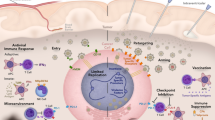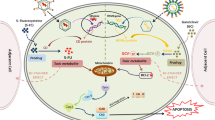Abstract
Somatic gene therapy with the herpes simplex virus type I thymidine kinase gene/ganciclovir (HSV-Tk/GCV) system and murine retroviral vector producer cells (VPCs) was introduced as a new adjuvant treatment modality to treat tumor bulk and to prevent tumor recurrence in patients harboring malignant glioma. The single-center experience after treatment of 27 patients undergoing tumor resection followed by intracerebral VPC injection for HSV-Tk suicide gene therapy will be presented focused on findings of systematic and close MRI follow-up and a few histological specimens. The data indicate that hemorrhagic necrosis due to endothelial cell transfection mediated vessel necrosis and that local inflammatory immune response occurs frequently after gene therapy. These phenomena seem to be specific because none of the patients of a control group showed any similar features. The prognosis (time to progression, survival) of the patients with “bystander effects” after gene therapy was better, but compared to those patients without bystander effects, they were also privileged by a favorable constellation of prognostic factors. Therefore, the appearance of these neuroradiologic features cannot serve as an indicator for treatment effectiveness and outcome. Cancer Gene Therapy (2001) 8, 843–851
This is a preview of subscription content, access via your institution
Access options
Subscribe to this journal
Receive 12 print issues and online access
$259.00 per year
only $21.58 per issue
Buy this article
- Purchase on Springer Link
- Instant access to full article PDF
Prices may be subject to local taxes which are calculated during checkout
Similar content being viewed by others
References
Moolten FL . Drug sensitivity (“suicide”) genes for selective cancer chemotherapy Cancer Gene Ther 1994 1: 279–287
Short MP, Choi BC, Lee JK, et al . Gene delivery to glioma cells in rat brain by grafting of a retrovirus packaging cell line J Neurosci Res 1990 27: 427–439
Miller DG, Adam MA, Miller AD . Gene transfer by retrovirus vector occurs only in cells that are actively replicating at the time of infection Mol Cell Biol 1990 10: 4239–4242
Lyons RM, Forry-Schaudies S, Otto E, et al . An improved retroviral vector encoding the herpes simplex virus thymidine kinase gene increases antitumor efficacy in vivo Cancer Gene Ther 1995 2: 273–280
Boviatsis EJ, Park JS, Sena-Esteves M, et al . Long term survival of rats harbouring brain neoplasms treated with ganciclovir and a herpes simplex virus vector that retains an intact thymidine kinase gene Cancer Res 1994 15: 5745–5751
Oldfield EH, Ram Z, Culver KW, et al . Gene therapy for the treatment of brain tumors using intra-tumoral transduction with thymidine kinase gene and intravenous ganciclovir Hum Gene Ther 1993 4: 39–69
Ram Z, Culver KW, Walbridge S, et al . In situ retroviral-mediated gene transfer for the treatment of brain tumors in rats Cancer Res 1993 53: 83–88
Moolten FL, Wells JM . Curability of tumors bearing herpes thymidine kinase genes transferred by retroviral vectors J Natl Cancer Inst 1990 82: 297–300
Ram Z, Culver KW, Oshiro EM, et al . Therapy of malignant brain tumors by intratumoral implantation of retroviral vector-producing cells Nat Med 1997 3: 1354–1361
Culver KW, Van Gilder J, Link CJ . Clinical protocol: Gene therapy for the treatment of malignant brain tumors with in vivo tumor transduction with the herpes simplex thymidine kinase gene/ganciclovir system Hum Gene Ther 1994 5: 343–379
Shand N, Weber F, Mariani L, et al . A phase 1–2 clinical trial of gene therapy for recurrent glioblastoma multiforme by tumor transduction with the herpes simplex thymidine kinase gene followed by ganciclovir Hum Gene Ther 1999 10: 2325–2335
Namba H, Tagawa M, Iwadate Y, et al . Bystander effect-mediated therapy of experimental brain tumor by genetically engineered tumor cells Hum Gene Ther 1998 9: 5–11
Freeman SM, Ramesh R, Shastri M, et al . The role of cytokines in mediating the bystander effect using HSV-Tk xenogenic cells Cancer Lett 1995 92: 167–174
Whartenby KA, Ramesh R, Marrogi AJ, et al . The biology of cancer gene therapy Lab Invest 1995 72: 131–145
Namba H, Iwadate Y, Tagawa M, et al . Evaluation of the bystander effect in experimental brain tumors bearing herpes simplex virus-thymidine kinase gene by serial magnetic resonance imaging Hum Gene Ther 1996 7: 1847–1852
Samejima Y, Meruelo D . “Bystander killing” induces apoptosis and is inhibited by forskolin Gene Ther 1995 2: 50–58
Freeman SM, Abboud CN, Whartenby KA, et al . The bystander effect: tumor regression when a fraction of the tumor mass is genetically modified Cancer Res 1993 53: 5274–5283
Culver KW, Ram Z, Walbridge S, et al . In vivo gene transfer with retroviral vector producer cells for treatment of experimental brain tumors Science 1992 256: 1550–1552
Moriuchi S, Krisky DM, Marconi PC, et al . HSV vector cytotoxicity is inversely correlated with effective TK/GCV suicide gene therapy of rat gliosarcoma Gene Ther 2000 7: 1483–1490
Ramesh R, Marrogi AJ, Freeman SM . Tumor killing using the HSV-tk suicide gene Gene Ther Mol Biol 1998 1: 253–263
Dilber MS, Abedi MR, Christensson B, et al . Gap junctions promote the bystander effect of herpes simplex virus thymidine kinase in vivo Cancer Res 1997 57: 1523–1528
Elshami AA, Saavedra A, Zhang H, et al . Gap junctions play a role in the bystander effect of the herpes simplex virus thymidine kinase/ganciclovir system in vitro Gene Ther 1996 3: 85–92
Ram Z, Walbridge S, Shawker T, et al . The effect on tumoral vasculature and growth of thymidine kinase-transduced, ganciclovir-treated 9L gliomas in rats J Neurosurg 1994 81: 256–260
Vile RG, Nelson JA, Castleden S, et al . Systemic gene therapy of murine melanoma using tissue specific expression of the HSV-Tk gene involves an immune component Cancer Res 1994 54: 6228–6234
Colombo BM, Benedetti S, Ottolenghi S, et al . The “bystander effect”: association of U-87 cell death with ganciclovir-mediated apoptosis of nearby cells and lack of effect in athymic mice Hum Gene Ther 1995 6: 763–772
Long Z, Lu P, Grooms T, et al . Molecular evaluation of biopsy and autopsy specimens from patients receiving in vivo retroviral gene therapy Hum Gene Ther 1999 10: 733–740
Deliganis AV, Baxter AB, Berger MS, et al . Serial MR in gene therapy for recurrent glioblastoma: initial experience and work in progress Am J Neuroradiol 1997 18: 1401–1406
Smith MM, Thompson JE, Castillo M, et al . MR of recurrent high-grade astrocytomas after intralesional immunotherapy Am J Neuroradiol 1996 17: 1065–1071
Henegar MM, Moran CJ, Silbergeld DL . Early postoperative magnetic resonance imaging following nonneoplastic cortical resection J Neurosurg 1996 84: 174–179
Albert FK, Forsting M, Sartor K, et al . Early postoperative magnetic resonance imaging after resection of malignant glioma: objective evaluation of residual tumor and its influence on regrowth and prognosis Neurosurgery 1994 34: 45–61
Ramesh R, Marrogi AJ, Munshi A, et al . In-vivo analysis of the “bystander effect”: a cytokine cascade Exp Hematol 1996 24: 829–838
Acknowledgements
We thank the staff of all cooperating institutions that were involved in the investigation of the specimens and gathering the data for our study. Especially, the assistance of Susanne Beyer and Michael Krämer from the Neurosurgical Institute of Electronic Data Processing in preparing the raw data and presenting the imaging is gratefully acknowledged.
Author information
Authors and Affiliations
Corresponding author
Rights and permissions
About this article
Cite this article
Floeth, F., Shand, N., Bojar, H. et al. Local inflammation and devascularization — in vivo mechanisms of the “bystander effect” in VPC-mediated HSV-Tk/GCV gene therapy for human malignant glioma. Cancer Gene Ther 8, 843–851 (2001). https://doi.org/10.1038/sj.cgt.7700382
Received:
Published:
Issue Date:
DOI: https://doi.org/10.1038/sj.cgt.7700382
Keywords
This article is cited by
-
Recent progress in the research of suicide gene therapy for malignant glioma
Neurosurgical Review (2021)
-
Enzyme/Prodrug Systems for Cancer Gene Therapy
Current Pharmacology Reports (2016)
-
Marmosets as a preclinical model for testing “off-label” use of doxycycline to turn on Flt3L expression from high-capacity adenovirus vectors
Molecular Therapy - Methods & Clinical Development (2014)
-
Gene therapy as an adjuvant treatment for malignant gliomas: from bench to bedside
Journal of Neuro-Oncology (2009)
-
The positive predictive value of O-(2-[18F]fluoroethyl)-l-tyrosine (FET) PET in the diagnosis of a glioma recurrence after multimodal treatment
Journal of Neuro-Oncology (2008)



